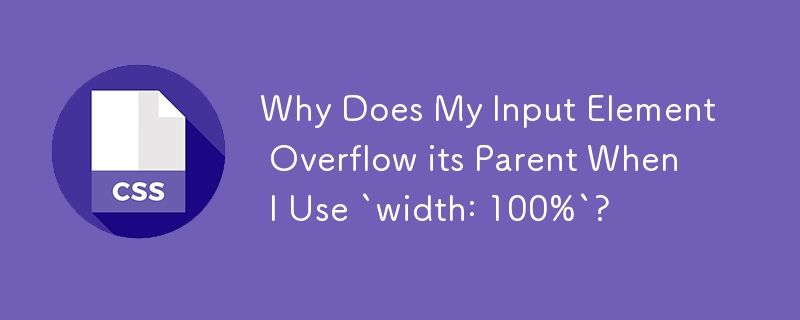 Web Front-end
Web Front-end
 CSS Tutorial
CSS Tutorial
 Why Does My Input Element Overflow its Parent When I Use `width: 100%`?
Why Does My Input Element Overflow its Parent When I Use `width: 100%`?
Why Does My Input Element Overflow its Parent When I Use `width: 100%`?

Understanding the Issue with CSS Input Bounds
In web development, it is common to encounter situations where HTML input elements exceed their parent's boundaries when width: 100% is applied. This issue arises due to the CSS box model, which explains how elements are sized and laid out.
The Box Model
The CSS box model considers an element's dimensions in four parts:
- Content Box: The innermost area containing the element's content, such as text or images.
- Padding: The space between the content box and the element's border.
- Border: The line surrounding the element.
- Margin: The space outside the border.
Impact of Padding on Dimensions
By default, the width and height properties of an element are applied to its content box. However, when padding is present, it extends beyond the content box, increasing the overall size of the element.
If you set width: 100% on an element with padding, the padding will push the element's width beyond 100% of its parent's width, causing it to exceed the boundaries.
Adjusting the Behavior with box-sizing
To prevent padding from affecting the element's width, you can set the box-sizing property to border-box. This tells the browser to include the padding within the element's width and height calculations.
Here's the CSS code using box-sizing:
input[type=text],
input[type=password] {
width: 100%;
box-sizing: border-box;
}Best Practice
Consider the following best practice for consistent sizing:
html {
box-sizing: border-box;
}
*,
*:before,
*:after {
box-sizing: inherit;
}This ensures that border-box sizing is inherited by all elements, avoiding potential inconsistencies.
The above is the detailed content of Why Does My Input Element Overflow its Parent When I Use `width: 100%`?. For more information, please follow other related articles on the PHP Chinese website!

Hot AI Tools

Undresser.AI Undress
AI-powered app for creating realistic nude photos

AI Clothes Remover
Online AI tool for removing clothes from photos.

Undress AI Tool
Undress images for free

Clothoff.io
AI clothes remover

Video Face Swap
Swap faces in any video effortlessly with our completely free AI face swap tool!

Hot Article

Hot Tools

Notepad++7.3.1
Easy-to-use and free code editor

SublimeText3 Chinese version
Chinese version, very easy to use

Zend Studio 13.0.1
Powerful PHP integrated development environment

Dreamweaver CS6
Visual web development tools

SublimeText3 Mac version
God-level code editing software (SublimeText3)

Hot Topics
 1664
1664
 14
14
 1422
1422
 52
52
 1316
1316
 25
25
 1266
1266
 29
29
 1239
1239
 24
24
 Google Fonts Variable Fonts
Apr 09, 2025 am 10:42 AM
Google Fonts Variable Fonts
Apr 09, 2025 am 10:42 AM
I see Google Fonts rolled out a new design (Tweet). Compared to the last big redesign, this feels much more iterative. I can barely tell the difference
 How to Create an Animated Countdown Timer With HTML, CSS and JavaScript
Apr 11, 2025 am 11:29 AM
How to Create an Animated Countdown Timer With HTML, CSS and JavaScript
Apr 11, 2025 am 11:29 AM
Have you ever needed a countdown timer on a project? For something like that, it might be natural to reach for a plugin, but it’s actually a lot more
 HTML Data Attributes Guide
Apr 11, 2025 am 11:50 AM
HTML Data Attributes Guide
Apr 11, 2025 am 11:50 AM
Everything you ever wanted to know about data attributes in HTML, CSS, and JavaScript.
 A Proof of Concept for Making Sass Faster
Apr 16, 2025 am 10:38 AM
A Proof of Concept for Making Sass Faster
Apr 16, 2025 am 10:38 AM
At the start of a new project, Sass compilation happens in the blink of an eye. This feels great, especially when it’s paired with Browsersync, which reloads
 How We Created a Static Site That Generates Tartan Patterns in SVG
Apr 09, 2025 am 11:29 AM
How We Created a Static Site That Generates Tartan Patterns in SVG
Apr 09, 2025 am 11:29 AM
Tartan is a patterned cloth that’s typically associated with Scotland, particularly their fashionable kilts. On tartanify.com, we gathered over 5,000 tartan
 How to Build Vue Components in a WordPress Theme
Apr 11, 2025 am 11:03 AM
How to Build Vue Components in a WordPress Theme
Apr 11, 2025 am 11:03 AM
The inline-template directive allows us to build rich Vue components as a progressive enhancement over existing WordPress markup.
 PHP is A-OK for Templating
Apr 11, 2025 am 11:04 AM
PHP is A-OK for Templating
Apr 11, 2025 am 11:04 AM
PHP templating often gets a bad rap for facilitating subpar code — but that doesn't have to be the case. Let’s look at how PHP projects can enforce a basic
 While You Weren't Looking, CSS Gradients Got Better
Apr 11, 2025 am 09:16 AM
While You Weren't Looking, CSS Gradients Got Better
Apr 11, 2025 am 09:16 AM
One thing that caught my eye on the list of features for Lea Verou's conic-gradient() polyfill was the last item:



